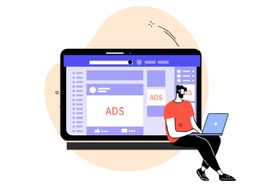Best Practices for PPC
Make every click count with proven PPC practices that boost visibility, increase conversions, and lower costs.
Published January 29, 2025.

Running a successful pay-per-click (PPC) campaign isn’t just about setting a budget and picking keywords—it’s about knowing how to make every click count. For businesses grappling with high competition or tight margins, poorly optimized PPC efforts can lead to wasted ad spend and underwhelming results. This often raises a critical question: Are your campaigns reaching their full potential, or are you leaving conversions on the table?
Whether you’re struggling with low click-through rates, high cost-per-clicks, or inconsistent ROI, effective PPC management can turn things around. With the right strategies, businesses can better allocate budgets, target relevant audiences, and consistently achieve measurable results. By focusing on best practices, companies can unlock new opportunities to improve performance while avoiding common pitfalls that derail campaigns.
Setting up for success
Pay-Per-Click (PPC) is an online advertising model where advertisers pay a fee each time their ad is clicked. This method allows businesses to buy visits to their sites, complementing organic traffic.
Keyword research
Grasping search intent is fundamental in PPC campaigns. By comprehending the reasons behind users' searches, advertisers can select keywords that align with potential customers' needs, leading to higher engagement and conversion rates.
Several tools assist in identifying high-performing keywords:
Google's Keyword Planner: Generates keyword ideas and provides metrics like search volume and competition levels.
Microsoft Advertising Keyword Planner: Offers similar functionalities tailored for the Microsoft Search Network.
Ahrefs: Provides comprehensive keyword research capabilities, focusing on competitor analysis and organic rankings.
Using these tools enables advertisers to refine their keyword strategies, ensuring ads reach the most relevant audiences.
Target audience identification
Defining the target audience involves analyzing demographics—such as age, gender, location, and income—and psychographics, including lifestyle, attitudes, and behaviors. This analysis helps in crafting messages that resonate with specific segments.
Audience data informs ad copy and placements by revealing which segments are most likely to convert. Insights into audience behavior guide the tone and content of ad copy, ensuring it appeals to the intended demographic. Additionally, understanding where the audience spends time online allows for strategic ad placements, maximizing visibility and effectiveness.
Implementing these practices lays a solid foundation for successful PPC campaigns, enabling advertisers to connect effectively with their target market and achieve desired outcomes.
Understanding PPC best practices is essential for advertisers to optimize ad spend, enhance campaign performance, and achieve marketing objectives effectively.
Crafting high-performing ads
Creating effective PPC ads involves strategic copywriting and thoughtful visual design to engage the target audience and drive conversions.
Ad copywriting tips
- Clarity and relevance: Ensure your ad copy is clear and directly addresses the searcher's intent. Incorporate relevant keywords that match user queries to signal that your ad aligns with their needs. For instance, if users search for "task management software," include this phrase in your ad to confirm its relevance.
- Highlight benefits: Focus on the unique benefits your product or service offers. Clearly communicate how it solves a problem or fulfills a need for the user. This approach helps differentiate your offering from competitors.
- Compelling calls to action (CTAs): Encourage users to take the desired action by including strong CTAs. Phrases like "Get Started Today," "Learn More," or "Sign Up Now" can prompt immediate responses. Ensure the CTA aligns with the landing page to provide a seamless user experience.
Examples of well-written PPC ads
Snickers – "You're Not You When You're Hungry": This campaign targeted common misspellings, displaying ads to users who made typographical errors, humorously suggesting they needed a Snickers bar.
Alec Brownstein's Job Search: Alec Brownstein bid on the names of prominent creative directors, ensuring his ads appeared when they Googled themselves. The ad read, "Hey, [Creative Director's Name]: Googling yourself is a lot of fun. Hiring me is fun, too." This personalized approach led to multiple job offers.
Designing effective visuals
→ The role of imagery in display ads
High-quality images in display ads capture attention and convey messages quickly. Visuals should be relevant to the product or service and resonate with the target audience.
Example: Using authentic images that reflect the lifestyle or aspirations of your audience can enhance engagement.
→ Optimizing visuals for mobile responsiveness
With the increasing use of mobile devices, it's essential to ensure that ad visuals are mobile-friendly. This includes using appropriate image sizes and formats to maintain quality across devices. Techniques like lazy loading can improve load times, enhancing user experience.
Advertisers can create PPC ads that perform well across various platforms and devices by focusing on clear, benefit-driven ad copy and incorporating effective, responsive visuals.
Budgeting and bidding strategies
Effective budgeting and bidding are essential components of a successful PPC campaign, enabling advertisers to maximize return on investment (ROI) and achieve specific marketing objectives.
Setting a realistic budget
Allocating your PPC budget requires aligning spend with your campaign goals. For lead generation campaigns, it's advisable to invest more in targeted keywords that attract potential customers ready to convert.
Conversely, for brand awareness initiatives, distributing the budget across broader keywords can increase visibility among a wider audience. Regularly reviewing and adjusting your budget based on performance metrics ensures optimal use of resources.
Choosing the right bidding strategy
→ Manual vs. automated bidding approaches
Selecting an appropriate bidding strategy depends on factors such as campaign goals, budget, and available management time.
Manual bidding offers control over individual keyword bids, allowing for precise adjustments based on performance data. This approach is beneficial when you have the expertise and time to manage bids actively.
Automated bidding strategies, on the other hand, use algorithms to adjust bids in real-time, aiming to achieve specific objectives like maximizing clicks or conversions within a set budget. Automated strategies can save time and leverage machine learning to optimize bids but may require careful monitoring to ensure they align with your goals.
→ When to experiment with bid adjustments
Regular experimentation with bid adjustments is vital to refine your PPC strategy. Testing different bidding approaches, such as adjusting bids based on device performance, geographic locations, or time of day, can provide insights into what drives the best results.
Implementing A/B tests allows you to compare the effectiveness of various bid strategies, enabling data-driven decisions to enhance campaign performance. Monitoring key performance indicators (KPIs) during these experiments helps in identifying successful tactics and areas needing improvement.
By thoughtfully setting budgets aligned with your objectives and choosing appropriate bidding strategies, you can effectively manage your PPC campaigns to achieve desired outcomes.
Landing page optimization
Optimizing landing pages is essential for enhancing the effectiveness of PPC campaigns, as it directly influences user engagement and conversion rates.
Relevance and consistency
Ensuring that landing pages align with ad messaging is vital. When users click on an ad, they expect the landing page to reflect the promises made. Consistency between the ad copy and the landing page content reassures visitors that they are in the right place, increasing the likelihood of conversion. For instance, if an ad promotes a "50% discount on running shoes," the landing page should prominently feature this offer.
Design and usability
→ Fast load times and mobile compatibility
Page load speed significantly impacts user experience. Slow-loading pages can lead to high bounce rates, as users may abandon the site if it doesn't load promptly. Additionally, with the increasing use of mobile devices, it's imperative to ensure that landing pages are mobile-friendly. Responsive design adapts the layout to various screen sizes, providing a seamless experience across devices.
→ Clear call to action (CTA) and minimal distractions
A well-defined CTA guides users toward the desired action, whether it's making a purchase, signing up for a newsletter, or downloading a resource. The CTA should be prominently displayed and use compelling language that encourages immediate action. Moreover, minimizing distractions on the landing page, such as excessive links or unrelated content, helps maintain the user's focus on the primary objective. A clean, uncluttered design directs attention to the CTA, enhancing the potential for conversions.
Focusing on relevance, consistency, design, and usability allows advertisers to create landing pages that effectively convert visitors, maximizing the return on investment for PPC campaigns.
Monitoring and Optimization
Regular monitoring and optimization are essential for maintaining and improving the performance of PPC campaigns.
Metrics to track
→ Click-through rate (CTR), Quality Score, and conversion rates
Monitoring key performance indicators (KPIs) such as click-through rate (CTR), Quality Score, and conversion rates provides valuable insights into your PPC campaign's effectiveness.
CTR measures the percentage of users who click on your ad after seeing it, indicating how compelling your ad is to your audience. Quality Score, determined by platforms like Google Ads, assesses the relevance and quality of your keywords and ads, influencing your ad's position and cost-per-click.
Conversion rates reveal the percentage of clicks that result in a desired action, such as a purchase or sign-up, reflecting your campaign's ability to drive valuable outcomes.
→ Calculating Return on Ad Spend (ROAS)
Return on Ad Spend (ROAS) is a metric that evaluates the revenue generated for every dollar spent on advertising. To calculate ROAS, divide the total revenue from your PPC campaign by the total ad spend.
For example, if your campaign generated $200 in revenue and you spent $100 on ads, your ROAS would be 2:1, meaning you earned $2 for every $1 spent.
A/B testing
→ Testing headlines, calls to action (CTAs), and visuals
A/B testing, also known as split testing, involves creating two versions of an ad with slight variations to determine which performs better. By testing different headlines, CTAs, and visuals, you can identify the elements that resonate most with your audience.
Example: Experimenting with different headlines can reveal which message drives higher engagement, while testing various CTAs can show which prompts lead to more conversions.
→ Leveraging insights to refine ads over time
The data collected from A/B testing provides actionable insights that can be used to refine your ads. By analyzing the performance of different ad variations, you can make informed decisions about which elements to implement in future campaigns. This iterative process allows for continuous improvement, ensuring your PPC ads become more effective over time.
Common Pitfalls to Avoid
In managing PPC campaigns, certain common mistakes can hinder performance and lead to wasted ad spend.
Overloading campaigns with too many keywords
Including an excessive number of keywords in your campaigns can dilute your focus and budget. It's more effective to target a refined list of high-intent keywords that closely align with your products or services. This approach ensures your ads reach the most relevant audience, improving the chances of conversion.
Ignoring negative keywords
Neglecting to implement negative keywords can result in your ads appearing for irrelevant searches, leading to unqualified traffic and unnecessary costs. By identifying and excluding terms that don't pertain to your offerings, you can prevent your ads from showing to users unlikely to convert, thereby optimizing your budget.
Neglecting ad refreshes or landing page updates
Failing to regularly update your ad creatives and landing pages can lead to ad fatigue and decreased engagement. Refreshing your ads with new headlines, visuals, and offers keeps your audience interested and can improve performance. Similarly, ensuring your landing pages are current and aligned with your ads enhances user experience and conversion potential.
By being mindful of these pitfalls and proactively addressing them, you can enhance the effectiveness of your PPC campaigns and achieve better results.
Advanced tips for PPC
To enhance the effectiveness of your PPC campaigns, consider implementing advanced strategies that leverage remarketing, artificial intelligence (AI), and dynamic ad formats.
Exploring remarketing campaigns for higher ROI
Remarketing involves targeting users who have previously interacted with your website or ads but did not convert. By displaying tailored ads to these individuals as they browse other sites, you can re-engage potential customers and encourage them to complete desired actions. Remarketing has been shown to significantly improve conversion rates and return on investment (ROI).
Using AI and automation to scale efforts
Integrating AI and machine learning into your PPC strategy can automate various aspects of campaign management, such as bid adjustments, audience targeting, and ad creation.
AI tools can analyze vast amounts of data to identify patterns and optimize campaigns in real-time, leading to improved efficiency and performance. For example, AI can help create personalized ads for different audience segments, enhancing relevance and engagement.
Dynamic ad formats and personalized targeting
Using dynamic ad formats allows for the automatic generation of ads tailored to individual users based on their behavior and preferences. This personalization can increase engagement and conversion rates.
Example: Dynamic search ads automatically create headlines and landing pages that match a user's search query, ensuring highly relevant ad experiences.
Additionally, personalized targeting, such as using customer data to segment audiences, enables more precise ad delivery and messaging.
Partner with leading paid advertising agencies through Mayple
If you’re ready to elevate your PPC campaigns, Mayple is here to help. Our platform connects you with vetted paid advertising experts who can craft strategies tailored to your business needs. Whether you’re seeking better ROI or enhanced ad performance, we’ll match you with the perfect online advertising company to achieve your goals.
Visit Mayple today and discover how we can transform your paid media strategy.









